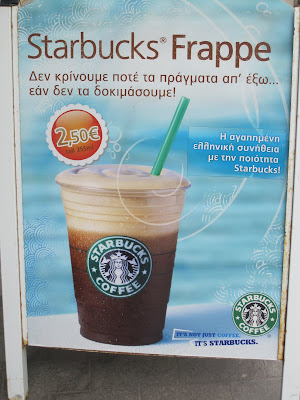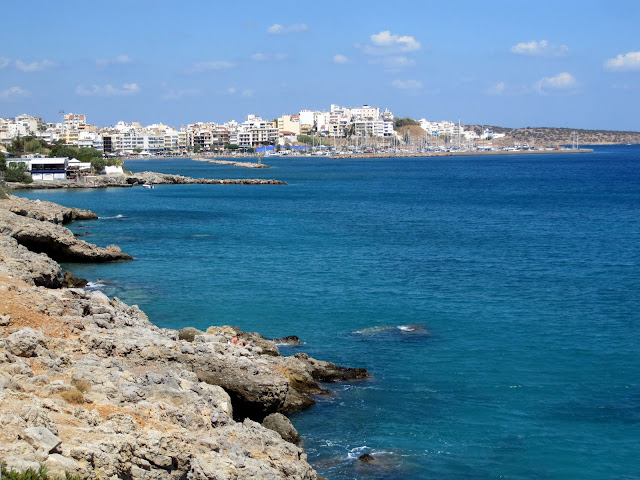 G: We got off the ship in the busiest port of Crete, Heraklion ("ir RAC leon"), then waved goodbye later that day as it sailed for Santorini (we know, but we'll get there another time!). We bought a used guide to Crete before we left the US only to discover that some 40 pages, including those about the Heraklion province, had been excised!
G: We got off the ship in the busiest port of Crete, Heraklion ("ir RAC leon"), then waved goodbye later that day as it sailed for Santorini (we know, but we'll get there another time!). We bought a used guide to Crete before we left the US only to discover that some 40 pages, including those about the Heraklion province, had been excised! G: After checking into a centrally-located hotel, we started walking. The first thing we noticed about this small city is the imposing Venetian-built fortress at the harbor's edge. Note the lion, symbol of Venice, in the wall of the castle.
G: After checking into a centrally-located hotel, we started walking. The first thing we noticed about this small city is the imposing Venetian-built fortress at the harbor's edge. Note the lion, symbol of Venice, in the wall of the castle. G: In the shadow of the Venetian fortress, a street guitarist was playing "Cuando, Cuando, Cuando." And while Jon was an attentive audience, I was trying to engage this cute little dog, but he had a mind of his own. If he were mine, he would have been named Tuffy.

J: The Starbucks sign advertises the traditional Greek coffee drink normally made with instant Nescafe--hey, it was Sunday morning and not much was open and yes, it tasted just like home! But they have much more interesting pastries in the case, like lemon tarts and macaroons. As stores began to open, we found all sorts of pedestrian walking streets and souvenir shops, but not much else..
This city is the jumping off point for an excursion to nearby Knossos, THE Minoan ruin. We will try to get there before we leave Crete.
G: FYI CRETE: geographically, running east/west, it is closer to Libya than Athens, 260km long and 60km at its widest point. It has only been a part of Greece since 1913. Before that Minoans, Dorian Greeks, Romans, Arabs, Byzantines, Venetians, Turks and the Germans during WWII all conquered the island at one time or another. Visually, it is a contrast of tan and red rocky mountains and barren hills mingled with valleys of olive trees that meet exquisite turquoise waters at bays and coves, some of which have small villages--but many are uninhabited. Beaches are narrow and some pebble and rock, others sand. But is hard to take my eyes off of the color of the water...which colors in the Crayola box describes those blues and turquoises?
We have read that once Crete was heavily forested, but cutting trees, especially in the Venetian period, compounded by goats' hunger for seedlings has turned the island into the barren rock we see today. And that produces erosion and dust, kicked up by the high winds from the north that blow in July and August.
 G: Catching a bus the next day from Heraklion (central north coast) to Agios Nikolaos, a small port town to the east, we arrived in the early afternoon to our prerented 2 room apartment. While we have a most exquisite view of the bay and marina from our bedroom and living room balconies, the apartment itself is just 50 sq.meters, just too small to spend 2 months here (which is what we planned). The apartment also has no comfortable reading chairs, but we do have a large bathroom and plenty of hot water. And just below us is a long straight lane filled with constant scooter, motorcycle, car and bus noises at all hours. Greeks love motorbikes, and not the little Vespa scooters -- big BMW bikes are everywhere.
G: Catching a bus the next day from Heraklion (central north coast) to Agios Nikolaos, a small port town to the east, we arrived in the early afternoon to our prerented 2 room apartment. While we have a most exquisite view of the bay and marina from our bedroom and living room balconies, the apartment itself is just 50 sq.meters, just too small to spend 2 months here (which is what we planned). The apartment also has no comfortable reading chairs, but we do have a large bathroom and plenty of hot water. And just below us is a long straight lane filled with constant scooter, motorcycle, car and bus noises at all hours. Greeks love motorbikes, and not the little Vespa scooters -- big BMW bikes are everywhere.So all in all, it is not a bad place, but we will be ready to move along after just two weeks. Luckily, the landlordess didn't ask for any money up front and is very gracious about letting us out of our two month commitment.
J: Here's the view from our apartment balcony at sunset. A soccer field, so far unused, surrounded by a track, which is used, is also part of our view. The water is actually the Bay of Mirabello and we look at mountains on the far eastern side of the bay. It's a two minute walk to a smallish sand beach right in the town. We prefer a 15 minute walk out of town to a long beautiful sand beach filled with umbrellas and recliners (6 Euros for two per day).
G: The town (20,000) of Agios Nikolaos (St. Nickolas) itself is perched on a hill spilling down to the harbor. Its one unusual attraction is a small bottomless lake which connects to the harbor by a canal. Except for the cafes and promenade that surround part of the lake, the city's buildings seemingly lack any kind of building code or plan. About every other day a huge cruise ship docks downtown, dwarfing the town and filling it with shoppers and gawkers. We have seen very few American tourists. Most of the visitors are German and British. After Greek, English is clearly the predominant language.
 G: A good bus system allows us to get out of town-- a short ride to the village port of Elounda, where we caught a boat for the 10 min. ride to the small island of Spinalonga, another Venetian fortress. But more importantly, this island was the last leper colony in Europe, active until 1957. Walking around the buildings of tumbling stone and rotting wood, it is hard to imagine how bleak life must have been for the colony that was forced to live here. This was a haunting tourist attraction.
G: A good bus system allows us to get out of town-- a short ride to the village port of Elounda, where we caught a boat for the 10 min. ride to the small island of Spinalonga, another Venetian fortress. But more importantly, this island was the last leper colony in Europe, active until 1957. Walking around the buildings of tumbling stone and rotting wood, it is hard to imagine how bleak life must have been for the colony that was forced to live here. This was a haunting tourist attraction. J: In our minimalist kitchen (two burners, no oven or microwave), G's managed to put together some delightful meals. This is truly "shop local" country. The produce, cheese and wine is all Cretan. We have had the most fragrant melons and sweetest table grapes. One of the distinguishing features of Crete in comparison to the other Greek islands is that Crete is the only self-sufficient island. Places like Santorini and Mykonos import everything. Here is a picture of the bowl of ingredients for lentil soup.
J: In our minimalist kitchen (two burners, no oven or microwave), G's managed to put together some delightful meals. This is truly "shop local" country. The produce, cheese and wine is all Cretan. We have had the most fragrant melons and sweetest table grapes. One of the distinguishing features of Crete in comparison to the other Greek islands is that Crete is the only self-sufficient island. Places like Santorini and Mykonos import everything. Here is a picture of the bowl of ingredients for lentil soup. J: Another day we took the bus into the mountains to Kritsa, a typical traditional village with one walking street lined with shops displaying embroidered linens, their specialty. At each door a widow in black, beckons us to come in with a "special price just for you." Again, more tourist shops with poorly painted copies of pottery in garish colors. We did enjoy the music by a Brit, who played flamenco guitar while we ate lunch. Note the blackboard at the Art Cafe -- certainly not pitching the local market.
J: Another day we took the bus into the mountains to Kritsa, a typical traditional village with one walking street lined with shops displaying embroidered linens, their specialty. At each door a widow in black, beckons us to come in with a "special price just for you." Again, more tourist shops with poorly painted copies of pottery in garish colors. We did enjoy the music by a Brit, who played flamenco guitar while we ate lunch. Note the blackboard at the Art Cafe -- certainly not pitching the local market. G: Finally on a closing note, here's my new friend from Kritsa, Charley. Do you know the artist who paints "The Blue Dog"? Charley could be his model.
G: Finally on a closing note, here's my new friend from Kritsa, Charley. Do you know the artist who paints "The Blue Dog"? Charley could be his model.

















